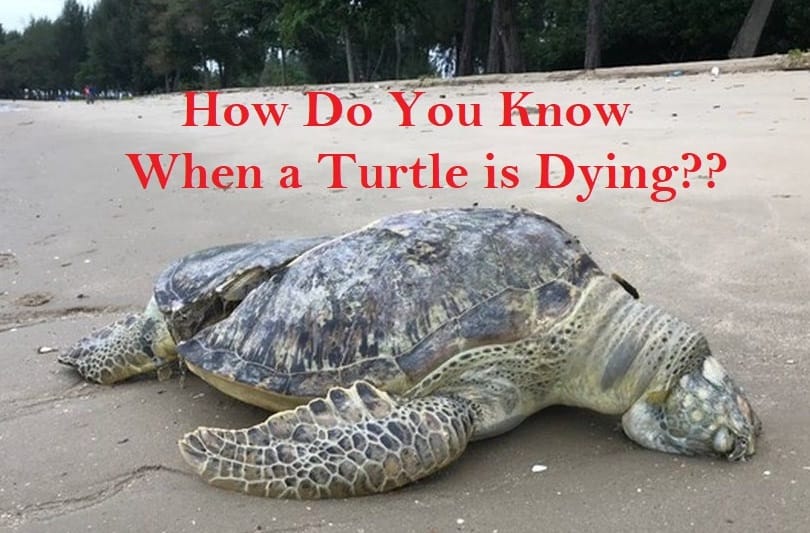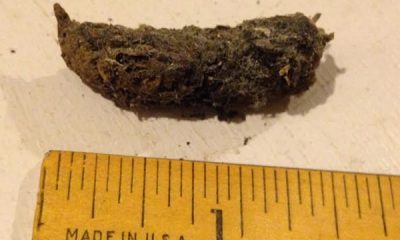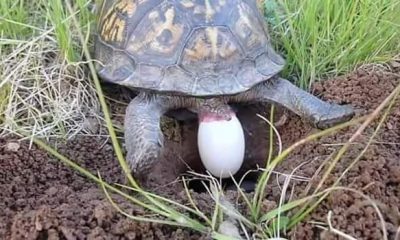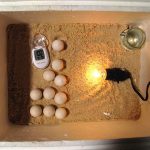Turtles
How Do You Know When a Turtle is Dying #Signs
Turtles care quite cute, and you love them the most. But, it is inevitable to find them dead one day. That can be devastating, but you cannot help it. Finding if a turtle is dead or hibernating can be a truly tough task. We just thought of helping you check out the clear signs to find how to know when a turtle is dying.
Contents
How to Tell if Your Turtle is Dying?
How do you know a turtle is dying? Like most of the aquatic and semi-aquatic animals, turtles tend to hide their illness and pain. You need to be careful in finding if the turtle is dying. A keen observation reveals that the right symptoms that indicate your turtle is dying include lethargy, lack of appetite, skin problems such as swelling in the eyes and other areas, bubbling and discharge and breathing problems. You may also notice swimming issues to indicate that the turtle is dying.

Like we said already, turtles show no indication about the pain or illness they are undergoing. However, you can find a few symptoms to indicate that the turtle is dying or approaching death. A few of the possible symptoms to tell you if your turtle is dying are:
Lack of Appetite
If your turtle refuses to eat, it is a clear indication to indicate that it is facing some issues or is dying. A hibernating turtle will not eat, but if you find a non-hibernating turtle that refuses to eat, it can be an invite to a serious investigation.
Refusal to eat and lack of appetite are the signs of gastrointestinal issues and an internal infection. It can happen in a female turtle when it has issues laying eggs. This issue is called dystocia. If your turtle is not eating and losing weight, it is an indication that it is dying.
Skin Problems
Swelling of skin in several areas is yet another indication that the turtle is dying. Swelling, especially around eyes is the most common issue you would find. The swelling can happen in the eyes, shells, and even on the shell. Tumours can be yet another indication that the turtle is dying.
Infections can be indicated through the appearance of wounds, lesions, holes along with red irritations. Consult your vet if you find any issues.
Lethargy
A normal and active turtle that shows a lethargic attitude, that can be a clear indication to prove that the turtle is dying. A normal turtle should move around the tank and stay active. It should also respond to any stimulation like food, and light.
If you find your turtle is not eating and does not move much or it is not swimming, you will find that it may be dying. It is high time you should contact your vet.
Discharge and Bubbling Issues
Runny discharge from noses, ears and eyes are a few of the issues to indicate that the turtle is extremely sick and maybe dying. Swollen eyelids and ears, accompanied by pus-like appearance are a few skin ailments you need to pay special attention to.
Bubbling from the mouth is yet another indication to prove that the turtle is dying. The bubbling can be caused by a respiratory infection or any other similar condition. It can also be due to Vitamin A deficiency.
Swimming Difficulty
A dying turtle may face difficulties in swimming. A few scenarios can include swimming to one side, or trouble in floating correctly. A turtle incapable of swimming can be an indication of severe health conditions.
If you notice that your turtle is showing up a lot of disorientation when swimming, it is a good idea to consult the vet. Lack of interest in swimming or an inability in swimming properly can mean that the turtle is dying, or is severely ill.
Breathing Problems
Breathing problems can obviously be an indication that the turtle is dying. The respiratory diseases can range across from being mild to severe. Some severe issues you may come across can include sneezing and gasping.
A dying turtle may also gape. Gaping is breathing from the mouth, and this can happen when the turtle is facing respiratory discomforts of severe nature. It may even bring its neck forward to suck in more air.
Recommended Reading – How to if a Turtle is Happy or Not?
How Can You Tell if Your Turtle is Dead?
There are a few signs that indicate whether your turtle is dead. A hibernating turtle may look similar to a dead turtle, but there are a few ways you can be assured that the turtle is dead.
Here are a few indicators to prove that your turtle is dead:
- Try Poking it – Almost every turtle responds to poking and prodding. If the turtle is alive, it will move, close its shell, or even hiss at you. The best way is to stimulate their legs and tail. If you find no response, however minor, it is a clear indication that the turtle is dead.
- Bad Smell – Dead turtles begin decomposing just like any other animals. If you get a terrible smell, it should be a good indication to conclude that your turtle is dead. In fact, the bad smell should be the first and prime sign that the turtle is dead. You would begin feeling the smell within a day of death.
- Put pressure to the Cloaca – Putting gentle pressure on a region between the cloaca and tail elicits a quicker response. If you find no response to this kind of stimulation from your turtle, it can be a clear indication to prove that the turtle is dead.
- The Floating test – A dead turtle will invariably float in water. The dead turtle has gases in its body, and these gases make it more buoyant. However, this may not be a conclusive test to indicate a dead turtle. The gases may not have developed enough to make a dead turtle float as yet. Or it may also happen that a living turtle may decide to float by its intuition.
- Breathing test – The test involves checking if the turtle is breathing. Unlike in humans and other animals, turtles do not breathe faster and finding their breathing may not be easy. You can perhaps keep a feather in front of their nostrils to check if the turtle is breathing or not.
How to Dispose of a Dead Turtle?
Disposing of a dead turtle can be a devastating experience on its own. But, no matter how much unfortunate it may be, you need to take care of the dead turtle and dispose of it in the best possible way.
Here are a few tips on how to dispose of a dead turtle:
- Never touch it – Touching a dead animal – whether turtle or anything else, is not a wise call. It can be extremely unhygienic and can create severe health issues. Using gloves can be a good idea here. Make sure you use disposable gloves.
- Bury it – If the turtle is small in size, burying it can be an easier option. There are a few precautions to follow when burying the dead turtle.
- Check Local dead animal removal service – Some regions have a dedicated dead animal removal service. If you have any such service, you can ask them to dispose of your dead turtle. Check out with your local sanitation department and find if they have any dead animal removal service.
- Contact your vet – If you do not want to hand over the dead turtle to the third-party service, and want to do it yourself, your vet would be in a better position to guide you on the procedure to follow. The vet can provide you with information on how to handle pet cremation effectively and efficiently.
Burial of Dead Turtle
Burial would be the best option to dispose of a dead turtle. They would be easy to bury if you have a yard or garden that can be used for the purpose. There may be specific rules that govern the proper burial.
- Use a bag, preferably plastic, to wrap the dead turtle. Put this into a box and then bury it into a deeper hole.
- Follow the guidelines on how deeper the burial hole should be. Most of the local guidelines stipulate the burial hole to be minimum 3 to 4 feet.
- Make sure you avoid the powerlines and other utility services when digging the burial hole
- Avoid the burial in places that are close to water bodies and other flood-prone areas.
- It may be a good idea to use some paving stones and similar other options to avoid the scavengers from digging the burial hole and dragging the dead animal out.
Well, this is a very morbid subject that we are dealing in and may perhaps be something you would not be comfortable with. But, this is something you would find quite inevitable and unavoidable. Being in the know well in advance can prove to be extremely helpful when the situation demands it.
My Turtle Died, How do I Keep the Shell?
Losing your beloved turtle is truly difficult and a painful event. However, turtles have become unique because of their shells. If you do not want to say goodbye to your turtle even after it is dead, preserving the shell should be a better option.
How to preserve the Turtle shell after it is dead? The tips and tutorial here should be extremely helpful.
Brumating vs a Dead Turtle – How to Differentiate?
A brumating turtle may often be seen as a dead turtle, and it can be quite confusing to find if the turtle is dead or just hibernating. When a turtle begins to bromate, the body movements slow down to a very low pace. To find if a turtle is just bromating or dead, you can check out for the signs of warmness and check if he warms up within a span of 24 hours.
Brumating is a process of hibernating. The behaviour is commonly seen in cold-blooded animals such as turtles whenever the ambient temperature goes below 50 degree F. Under ideal conditions, you would find the turtle pass an entire winter in this state. Brumating or hibernating is a very slow pace of activity where the turtle may even stop eating.
The major difference between a dead turtle and a bromating turtle lies in the fact that a dead turtle emits odour – in around 24 hours time. You should typically not disturb a brumating turtle as much as possible. Ideally, turtles dig a hole in the substrate and spend their brumation period in the hole.
Just in case you need to break the brumating phase of the turtle, it would be advisable to place him in a warmer place. Make sure that the body temperature of the turtle increases gradually over a period of 24 hours. If the turtle is alive and is into hibernation, he will slowly warm up and show the signs of activity.
A pet turtle can go into brumation if the owner does not provide proper care and does not provide a warmer environment to the animal.
Why Would a Turtle Die Suddenly?
The reasons for a turtle to die suddenly can include underfeeding, overheating, lack of hygiene and cleanliness, stress and illnesses. Further putting too much or too little water inside their tank, or grabbing and picking them up too often can be the cause.
The Closing Thoughts
Well, that was a purely a morbid post, and perhaps something that you do not want to think of when you are looking for information on turtles. But, that is something inevitable and cannot be avoided. You will need to be careful in handling your turtle if it is dying and dispose of a dead turtle in the most possible humane way.
We assume the tips share here would ideally help you go through this sad phase in your pet’s life with complete patience and care.

-

 Skunk4 years ago
Skunk4 years agoWhat Does Skunk Poop Look Like? Images & Identifications
-

 Bunny4 years ago
Bunny4 years agoPregnant Rabbit Labor Signs #Test#Symptoms#Age#Length
-

 Turtles5 years ago
Turtles5 years agoHow To Take Care of Turtle Egg At Home?
-

 Turtles4 years ago
Turtles4 years ago8 Basking Rocks/ Platforms for Turtles – A Perfect Guide
-

 Bunny5 years ago
Bunny5 years agoHow to Get Rid of Mites on Rabbits? #NaturalRemedies #Video
-

 Horse4 years ago
Horse4 years agoHow Much Weight Can a Horse Carry? #Clydesdale #Friesian #Mustang #Draft
-

 Turtles4 years ago
Turtles4 years agoHow to Take Care of Snapping Turtle Eggs? #Incubating #Hatching
-

 Bunny5 years ago
Bunny5 years agoHow to Potty Train a Rabbit in House? Tips on Litter Training



















